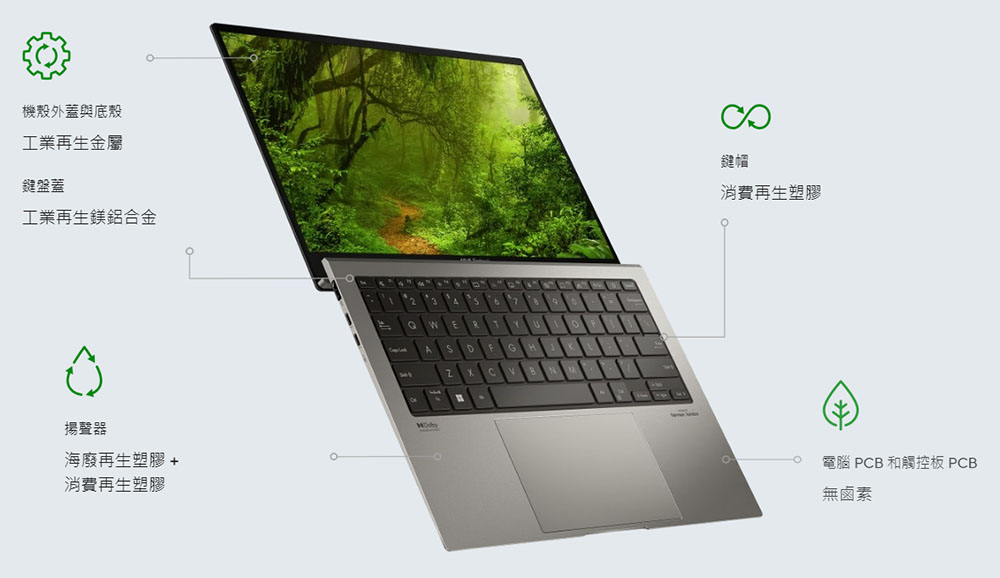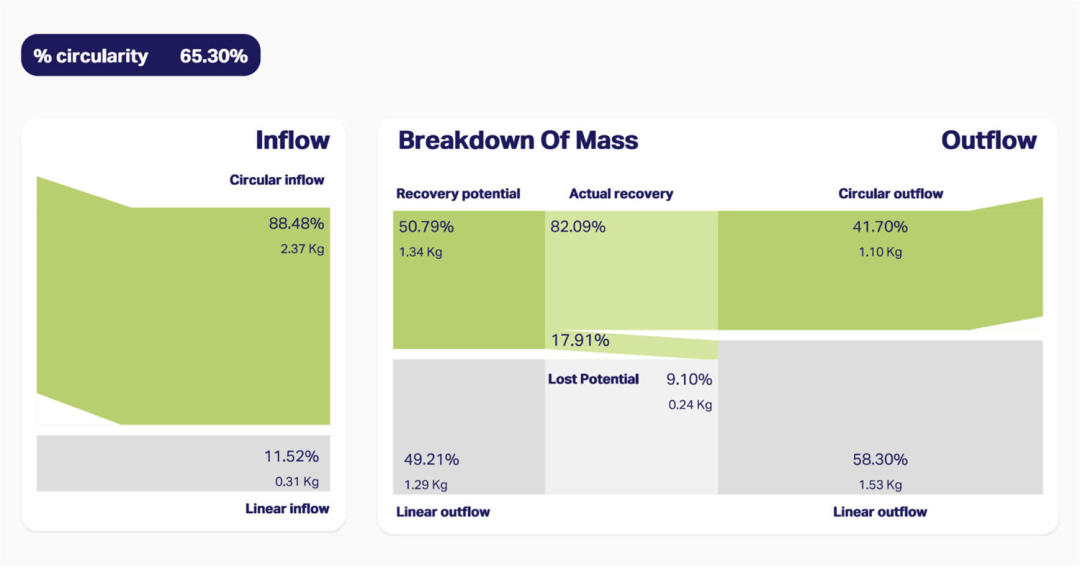Circular Transition Indicators Case Study | Latest Information | ASUS ESG website, ASUS ESG goal
Feature Story
2024/01/30
Circular Transition Indicators Case Study
-
Copied to clipboard
“At ASUS, we advocate that sustainability performance should involve strategic indicators that can be objectively measured. Every decision-making process needs to incorporate environmental and social factors to help keep our competitive advantage focused on sustainability. This is consistent with the CTI goal of helping companies maximize their circularity, including recycling, regeneration and reuse.”
TS Wu, ASUS Chief Sustainability Officer
Addressing the electronic waste crisis in a digital era
ASUS is a multinational computer hardware and consumer electronics company. Recognizing the detrimental effects of the current linear electronics system, ASUS has embraced a shift to a circular economy as a critical lever to achieve sustainable development. To effectively measure its circular performance, ASUS used the Circular Transition Indicators (CTI) v4.0, a comprehensive framework of circularity metrics developed by the World Business Council for Sustainable Development (WBCSD). By assessing the circularity of its products and integrating CTI assessment results into the design thinking process, the company was able to develop a more sustainable and circular design for its laptop Zenbook S13 OLED. As a result, ASUS almost doubled its circularity, going from 35% to 65%.
The COVID-19 pandemic acted as a catalyst for digitalization, pushing various industries and consumers to embrace new technologies and digital solutions for accessing essential services such as healthcare and education. ASUS, as a leading company in the digital era, aims to cater to new consumer needs while making a positive impact on both people and the planet.
As a result of the linear "take, make, waste" system, more than 50 million metric tonnes of electronic waste is created annually worldwide1. This is equivalent to the weight of around 10 Great Pyramids of Giza. To reverse this trend, ASUS is committed to taking a leading role in the transition to circular electronics and supporting the development of a circular economy that maximizes the value of products, components and materials throughout their life cycles.
Circular economy targets
The circular economy is a key topic for the company as it is a lever to improve environmental performance and create new business opportunities. ASUS has set ambitious goals to promote sustainable procurement and double the use of environmentally friendly materials in products and packaging by 2025 compared to 2020, as defined in ASUS Sustainability Report 2022. The company also aims to reach a recycling rate of 20% for its products across the world. To attain these objectives, ASUS is replacing virgin materials with secondary (non-virgin materials), setting up take-back schemes to collect broken laptops and improving critical recycling infrastructure.
Assessing the circularity of the Zenbook S13 OLED with CTI
To gauge its progress toward achieving circular economy goals, ASUS conducted an in-depth analysis of the circular performance of one of its laptops, the Zenbook S13 OLED, using WBCSD's Circular Transition Indicators (CTI). Specifically, the material circularity and water circularity indicators were selected to measure the company’s effectiveness in closing material and water loops, while a separate indicator was chosen to quantify renewable energy use in the laptop production. To run this assessment, ASUS collected data on material composition, end-of-life, energy and water consumption. The company used CircularIQ's CTI Tool to streamline the data collection and calculations.
CTI has eleven different indicators that a company can select to measure its circular performance. ASUS chose the following:
- Material circularity indicator
The first CTI indicator that the company selected was the % material circularity indicator. This indicator expresses the effectiveness of a company in closing its material loops by measuring the company's ability to minimize resource extraction and waste materials. For the product design team, this meant analyzing the current materials used in the laptop and identifying opportunities to substitute linear materials with environmentally friendly ones. Data collection on the current material composition of the laptop was easy for the company. ASUS mentions that the assessment required hundreds of primary data points upstream in the supply chain of the laptop. ASUS has a strict system control for supply chain and product management. That meant that they could easily obtain the required data from the Supplier Chain Management System (SCM) and Product Lifecycle Management systems (PLM).
- Renewable energy indicator
A circular economy requires a transition to using renewable energy sources. The company selected the % renewable energy indicator to measure renewable energy consumption and has, as a result of the assessment, adopted larger-scale renewable energy policies.
- Water circularity indicator
The water circularity indicator was selected to look for ways to minimize the water footprint of the laptop.
Using CTI in design thinking
Recognizing that more than 80% of environmental impacts over a product's entire life cycle is determined in the design phase2, ASUS integrated the results from the CTI assessment into its design thinking process to produce a more circular laptop. This helped them almost double the % material circularity of the Zenbook S13 OLED.
Circular opportunities
In the pursuit of circular alternatives for the exterior metal parts of the laptop, ASUS faced the challenge of balancing consumers' requirements for elegant, lightweight and environmentally friendly materials with commercial viability and technical feasibility. The company had to find new material sources that could replace virgin materials. ASUS indicated this was the hardest part of the assessment as the research & development department conducted many engineering tests on different surface treatments and alloy metal combinations to find the optimal circular material. Meanwhile, procurement and project teams evaluated the feasibility of production at scale. Finally, the company came up with a new, more circular design. The company decided to introduce more recycled metals, use more recycled plastic (including ocean-bound plastics) and optimize the packaging. Figure 1 shows the circular design as a result of the CTI assessment.
Figure 1 Circular interventions on ASUS Zenbook S13 OLED

With these interventions, the company almost doubled the material circularity percentage of the Zenbook S13 OLED, going from 35% to 65% (Figure 2). Circular inflow, which expresses the percentage of secondary and renewable resources of the total purchased materials, now stands at 88.48%. Circular outflow measures what percentage of materials get recovered after end-of-life. The company improved its circular outflow by implementing a modular design of the laptop that is easy to disassemble and maintain.
Figure 2 CTI results % material circularity ASUS Zenbook S13 OLED after circular interventions

The value of CTI
ASUS highlights the value of CTI as an empowering decision-making framework that is backed by data and evidence. It helped the company garner recognition and foster collaboration with its business team and supply chain. By leveraging CTI, the company found the most suitable action plan, which led to a successful redesign of the laptop and the development of a "make-use-return" business model. ASUS concludes that the CTI assessment provided precise guidance on how to incorporate more renewable resources, increase recyclability, and reduce the environmental impact of a laptop throughout its life cycle. As a leading brand, ASUS felt compelled to take the lead in driving sustainability. The company's readiness to explore novel ideas in combination with the metrics-based approach offered by CTI has helped ASUS get closer to reaching its circularity goals.
1. Forti et al. (2020) The E-waste Monitor 2020: Quantities, flows, and the circular economy potential. Accessible at https://ewastemonitor.info/wp-content/uploads/2020/11/GEM_2020_def_july1_low.pdf
2. An introduction to circular design, retrieved from: https://ellenmacarthurfoundation.org/news/an-introduction-to-circular-design
Reference:
CTI case study - ASUS
Related Article

